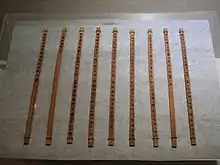Shuihudi Qin bamboo texts
The Shuihudi Qin bamboo texts (simplified Chinese: 睡虎地秦简; traditional Chinese: 睡虎地秦簡; pinyin: Shuìhǔdì Qín jiǎn) are early Chinese texts written on bamboo slips, and are also sometimes called the Yúnmèng Qin bamboo texts. They were excavated in December 1975 from Tomb #11 at Shuìhǔdì (睡虎地) in Yunmeng County, Hubei, China. The tomb belonged to a Qin administrator of c. 217 BCE.[1]

Written in the Qin dynasty, the texts record Qin laws and public documents. Their contents have been published in the book 《睡虎地秦墓竹簡》 (Shuìhǔdì Qínmù Zhújiǎn). This cache of bamboo slips is of great importance for research into the government, economics, culture, law, military affairs, etc. of the late Warring States to the Qin period.
While the Shuihudi cache is deemed to be among the most valuable epigraphic sources on the Qin history, the discoveries of the Qin Slips of Liye in 2002 and 2005 are regarded as being of equal, if not bigger, importance.[2]
See also
Bibliography
- Hulsewé, A.F.P. Remnants of Ch'in Law: An Annotated Translation of the Ch'in Legal and Administrative Rules of the 3rd Century BC. (Sinica Leidensia, No 17) Leiden: Brill, 1985.
References
- http://www.kaogu.cn/uploads/soft/Chinese%20Archaeology/7/Shuihudi's%20Bamboo%20Strips%20of%20Qin%20Dynasty%20and%20Mathematics%20in%20Pre-Qin%20Period.pdf
- Yuri Pines, Gideon Shelach, Lothar von Falkenhausen, Robin D.S. Yates (eds.). Birth of an Empire:The State of Qin Revisited, 2013:10.